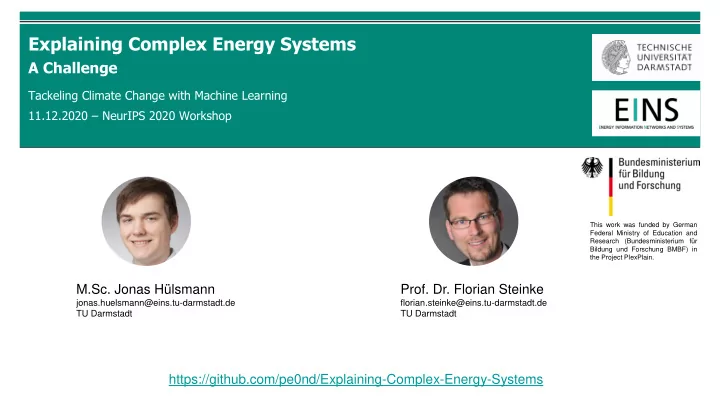

Explaining Complex Energy Systems A Challenge Tackeling Climate Change with Machine Learning 11.12.2020 – NeurIPS 2020 Workshop This work was funded by German Federal Ministry of Education and Research (Bundesministerium für Bildung und Forschung BMBF) in the Project PlexPlain. M.Sc. Jonas Hülsmann Prof. Dr. Florian Steinke jonas.huelsmann@eins.tu-darmstadt.de florian.steinke@eins.tu-darmstadt.de TU Darmstadt TU Darmstadt https://github.com/pe0nd/Explaining-Complex-Energy-Systems
The challenge: How to explain innovative energy systems to non-experts Innovative energy systems are typically planned based on models that have a simple LP structure but large • numbers of variables and parameters Outputs are also large scaled and their internal logic is hard to extract • 321 pages [1] 810 pages [2] 400 pages [3] 290 pages [4] ➢ These studies are the basis for desicions made by managers, politicans or citizens (= non-experts) ➢ Explanation needed (as for complex ML models)
We provide a simple Energy System Model for test purposes* Energy system model of single household • Minimizes cost by choosing PV and battery capacity • Time series for PV availabilty and electric demand • One year simulation (hour resultion) • 4 Inputs – PV price, battery price, electriciy price (from grid), total demand • 5 Outputs – PV capacity, battery capacity, own generation, TOTEX, CAPEX *pyomo model available at https://github.com/pe0nd/Explaining-Complex-Energy-Systems
We provide a simple Energy System Model for test purposes Input: Modell: Output: 𝑇 𝐷𝑏𝑞,𝑞 cost = 𝑑 𝑄𝑊 × 𝐷𝑏𝑞 𝑄𝑊 + 𝑑 𝐶𝑏𝑢 × 𝐷𝑏𝑞 𝐶𝑏𝑢 min + 𝑑 𝐶𝑣𝑧 × 𝑞 𝐶𝑣𝑧 (𝑢) Photovoltaik Capacity PV 𝑢 𝐷𝑏𝑞 𝑄𝑊 𝑑 𝑄𝑊 s.t. 𝑝𝑣𝑢 𝑢 − 𝑞 𝐶𝑏𝑢 𝑗𝑜 𝑞 𝐶𝑣𝑧 𝑢 + 𝑞 𝑄𝑊 𝑢 + 𝑞 𝐶𝑏𝑢 𝑢 = 𝐸 𝑢 , ∀𝑢 Capacity battery Batteriestorage 𝑇 𝐷𝑏𝑞 𝐶𝑏𝑢 𝑝𝑣𝑢 𝑢 , 𝑢 ∈ 2 … 𝑈 𝑇 𝑇 𝑗𝑜 𝑞 𝐶𝑏𝑢 𝑢 = 𝑞 𝐶𝑏𝑢 𝑢 − 1 + 𝑞 𝐶𝑏𝑢 𝑢 − 𝑞 𝐶𝑏𝑢 𝑑 𝐶𝑏𝑢 Own generation 0 ≤ 𝑞 𝑄𝑊 𝑢 ≤ 𝐷𝑏𝑞 𝑄𝑊 × 𝑏𝑤𝑏𝑗𝑚 𝑄𝑊 𝑢 × ∆𝑢, ∀𝑢 𝑞 𝑄𝑊 (𝑢) ÷ 𝐸(𝑢) Energy demand 𝑗𝑜 (𝑢) , 𝑞 𝐶𝑏𝑢 𝑝𝑣𝑢 𝑢 ≤ 𝐷𝑏𝑞 𝐶𝑏𝑢 𝑇 𝑢 𝑢 0 ≤ 𝑞 𝐶𝑏𝑢 , ∀𝑢 𝐸(𝑢) CAPEX 𝑇 𝑇 𝑞 𝐶𝑏𝑢 0 = 𝑞 𝐶𝑏𝑢 𝑈 𝑇 𝑑 𝑄𝑊 × 𝐷𝑏𝑞 𝑄𝑊 + 𝑑 𝐶𝑏𝑢 × 𝐷𝑏𝑞 𝐶𝑏𝑢 Power grid 0 ≤ 𝑞 𝐶𝑣𝑧 𝑢 , ∀𝑢 TOTEX 𝑑 𝐶𝑣𝑧 𝐷𝐵𝑄𝐹𝑌 + 𝑞 𝐶𝑣𝑧 𝑢 × 𝑑 𝐶𝑣𝑧 𝑢
We provide a simple Energy System Model for test purposes Input: Modell: Output: 𝑇 𝐷𝑏𝑞,𝑞 cost = 𝑑 𝑄𝑊 × 𝐷𝑏𝑞 𝑄𝑊 + 𝑑 𝐶𝑏𝑢 × 𝐷𝑏𝑞 𝐶𝑏𝑢 min + 𝑑 𝐶𝑣𝑧 × 𝑞 𝐶𝑣𝑧 (𝑢) Cost equation Photovoltaik Capacity PV 𝑢 𝐷𝑏𝑞 𝑄𝑊 𝑑 𝑄𝑊 s.t. 𝑝𝑣𝑢 𝑢 − 𝑞 𝐶𝑏𝑢 𝑗𝑜 𝑞 𝐶𝑣𝑧 𝑢 + 𝑞 𝑄𝑊 𝑢 + 𝑞 𝐶𝑏𝑢 𝑢 = 𝐸 𝑢 , ∀𝑢 Energy balance equation Capacity battery Batteriestorage 𝑇 𝐷𝑏𝑞 𝐶𝑏𝑢 𝑝𝑣𝑢 𝑢 , 𝑢 ∈ 2 … 𝑈 𝑇 𝑇 𝑗𝑜 𝑞 𝐶𝑏𝑢 𝑢 = 𝑞 𝐶𝑏𝑢 𝑢 − 1 + 𝑞 𝐶𝑏𝑢 𝑢 − 𝑞 𝐶𝑏𝑢 Battery equation 𝑑 𝐶𝑏𝑢 Own generation 0 ≤ 𝑞 𝑄𝑊 𝑢 ≤ 𝐷𝑏𝑞 𝑄𝑊 × 𝑏𝑤𝑏𝑗𝑚 𝑄𝑊 𝑢 × ∆𝑢, ∀𝑢 PV production limit 𝑞 𝑄𝑊 (𝑢) ÷ 𝐸(𝑢) Energy demand 𝑗𝑜 (𝑢) , 𝑞 𝐶𝑏𝑢 𝑝𝑣𝑢 𝑢 ≤ 𝐷𝑏𝑞 𝐶𝑏𝑢 𝑇 𝑢 𝑢 0 ≤ 𝑞 𝐶𝑏𝑢 , ∀𝑢 Battery charging limit 𝐸(𝑢) CAPEX 𝑇 𝑇 𝑞 𝐶𝑏𝑢 0 = 𝑞 𝐶𝑏𝑢 𝑈 Battery inital state 𝑇 𝑑 𝑄𝑊 × 𝐷𝑏𝑞 𝑄𝑊 + 𝑑 𝐶𝑏𝑢 × 𝐷𝑏𝑞 𝐶𝑏𝑢 Power grid 0 ≤ 𝑞 𝐶𝑣𝑧 𝑢 , ∀𝑢 TOTEX Power buying limit 𝑑 𝐶𝑣𝑧 𝐷𝐵𝑄𝐹𝑌 + 𝑞 𝐶𝑣𝑧 𝑢 × 𝑑 𝐶𝑣𝑧 𝑢
How could an explanation look like? Ideas for the simple energy model decision tree structural causal model Challenge: • Can interpretable ML methods be used for this purpose? • How to measure the quality of an explanation?
References [1] Ram, M., et al. "Global energy system based on 100% renewable energy – power, heat, transport and desalination sectors." Study by Lappeenranta University of Technology and Energy Watch Group, Lappeenranta, Berlin (2019). [2] IEA (2019), World Energy Outlook 2019 , IEA, Paris https://www.iea.org/reports/world-energy-outlook-2019 [3] IEA (2020), Energy Technology Perspectives 2020, IEA, Paris https://www.iea.org/reports/energy-technology-perspectives-2020 [4] Gerbert, Philipp, et al. Klimapfade für Deutschland . BCG, The Boston Consulting Group, 2018.
Recommend
More recommend